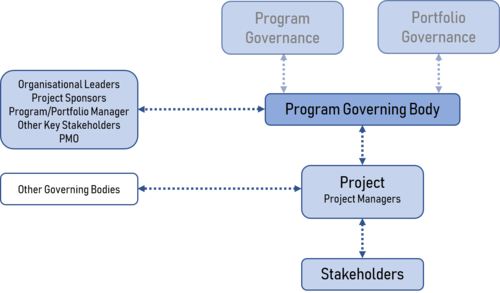Governance of Project Management
Contents |
Abstract
It appears that project governance is an ambiguous concept that suffer under a lack of an agreed on, generally accepted definition. This leads to the organisations developing their own understanding or interpretation of the concept, project governance, which fit their individually perspectives[1]. To investigate a common definition or use of project governance, the concept can be looked at from a bottom view or a top-down perspective. This article will focus on investigating the top-down perspective and look at governance starting at the corporate level and being implemented in project management through governance of project management. At the corporate level in an organisation, governance begins with the Board of Directors defining the objectives of the company and the role of projects in attaining these objectives[2]. Corporate governance also involves the relationships between the organisation’s board, management, shareholders, and other stakeholders[1][3]. The link between the corporate governance and the activities of project management within an organisation is called the governance of project management. It ensures that the project portfolio of an organisation is aligned to its objectives and is sustainable and delivered efficiently[3]. Different frameworks, principles and models has been established to guide project governance in an organisation. The three addressed in this article are; the thirteen principles of project governance which will help an organisation to avoid project failures developed by Association for Project Management (APM)[3], a guide to project governance framework implementation provided by Project Management Institute (PMI)[4], and the Project Governance Model for non-profit organisations proposed by Dr. Patrick S. Renz[5].
Project Governance
When talking about governance it is important to differentiate between the several different types that may exist. These include organisational governance, organisational project management (OPM) governance, and portfolio, program and project governance[6]. This article will mainly focus on the governance at a project level.
The main difference between governance at a project level and governance at a portfolio or program level is that project governance provides guidance and oversight for project management activities in order to deliver a product, service, or result. [4] Project governance is in the standard of Project Management Institute (PMI) defined as “the framework, functions, and processes that guide project management activities in order to create a unique product, service, or result to meet organizational, strategic, and operational goals”.[6] Governance framework refers to the four governance domains; alignment, risk, performance, and communication, with functions; oversight, control, integration and decision making, processes and activities for projects. The project governance framework will be further elaborated in the section of Implementation of Governance at a Project Level together with principles to avoid project failure and the Project Governance Model (for non-profit organisations).
Project governance is needed to ensure appropriate engagement of stakeholders and to guide and oversee the management of a project execution. It helps overcoming some of the challenges that may occur in the process of meeting the competing objectives of the project Triple Constraint: time, cost, and scope. In the every day changing and dynamic business environment, project governance should provide guidance for inputs, validations of projects and product requirements, effective execution, and the quality of the results. [4] To achieve this there are several processes that should be included in the project governance:
- Guiding an overseeing the management of project work by appropriate involvement in projects and interactions with the project manager on a regular basis
- Getting the appropriate people involved and ensuring engagement of the stakeholders
- Ensuring adherence to policies, standards, and guidelines
- Establishing governance roles, responsibilities, and authorities
- Decision-making regarding risk escalations, changes, and resources
- Monitoring performance[6]
Project Governance Organisation
The requirements of project governance should be looked at in the context of the project and organisational environment. If three separate scenarios of governing a project is looked at, an example of a project governance organisation structure could be as shown in figure ….
The three scenarios in which a project may be governed are: as a stand-alone project, within a program, or within a portfolio. In the case of a project being in a program or a portfolio, the project governance has interactions with the governance of the program or portfolio. When the project is a stand-alone project outside a program or portfolio it has its own, separate governing body. Then organisational leaders, project sponsor, program or portfolio managers, project, program, and portfolio management office (PMO), or other key stakeholders possible involved in the project are members of the project governing body. Next step in the structure is the interactions between this governing body and the project and project manager and then with the involved stakeholders.[4] As the figure shows, the possibility of other governing bodies interacting with the project and project manager is also a case. This scenario will be addressed in the next section.
There are many different responsibilities concerning project governance for the implicated in a project. The key project governance roles are the governing body, the project sponsor, the project manager, other key stakeholders and the PMO, but there may be additional roles depending on the complexity of the project. It is of most importance that the project governance come up with a plan which identify and describe the roles and responsibilities in a project. The roles and their responsibilities are described by PMI as:
| Key Project Governance Roles | Roles | Responsibilities |
|---|---|---|
| Project Governing Body |
|
|
| Project Sponsor |
|
|
| Project Manager |
|
|
| Other Key Stakeholders |
|
|
| Project Management Office (PMO) |
|
|
Governance in a Multi-Organisation Environment
In the case where a project has multiple governing organisation it is even more important to define and clarify project governance. Such a case would typically be on a larger, more complex project where responsibilities will be distributed among a larger set of people.[7] It could be that the project receive financial or in-kind contributions from several sources, e.g. the government, the target group, or other donors, which will arise the question of whose responsibility it is to govern the project.[5] In this case the relationship between the project management and the governance is more complicated than in the one-to-one scenario since some roles and responsibilities are being shared. Therefore, the primary concern in a multi-organisation environment is to ensure clarification of individual accountabilities, limits of delegation and authority, and governance within the project.[7]
Implementing Governance at a Project Level
Every project is unique in terms of complexity, uncertainty, and risk levels that affect the managing and governing of the project. Project governance provide the needed guidance to project managers, sponsors, and stakeholders within the organisation. In the next sections three different guides to implement project governance at the project level will be presented.
Project Governance Framework
A project governance framework provides the project management team with structure, processes, decision making models, and tools for managing the project, while monitoring the quality of the project for at successful delivery. [4] Because of the different levels of complexity, uncertainty and risk in projects, it is impossible to have one governance framework that fits all projects. However, PMI provides a general categorisation of domains, functions, and processes that can be customised to any specific project and will help guide organisations in the implementation of governance in projects.
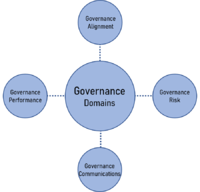
The four governance domains are described as: [4]
Governance Alignment Domain: Functions and processes to create and maintain an integrated governance framework.
Governance Risk Domain: Functions and processes to identify and resolve threats and opportunities to ensure balance of risk and reward.
Governance Performance Domain: Functions and processes to ensure measurement and evaluation of key performance indicators (KPIs) against parameters and realisation of business value.
Governance Communications Domain: Functions and processes to spread information, engage stakeholders, and ensure organisational change.
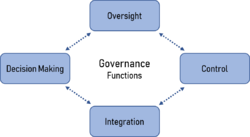
The four governance functions, within each of the four domains, categorise critical processes and activities that are performed to provide for the project of an organisation. The four governance functions are described as: [4]
Oversight function: Processes and activities that provide guidance, direction, and leadership for projects.
Control function: Processes and activities that provide monitoring, measuring, and reporting for projects.
Integration function: Processes and activities that provide strategic alignment for projects.
Decision making function: Processes and activities that provide structure and delegations of authority for projects.
Implementation
The guide to project governance by PMI provides a four-step implementation approach that regard implementation and ongoing improvement of governance processes throughout the lifecycle of the project. The four steps can be done in a parallel, overlapping or linear progression, though it is important to establish, define, and plan governance in the beginning of the life cycle. The four steps of the implementation are: assess, plan, implement, and improve. In the figure below the implementation approach provided by PMI is summarised: [4]
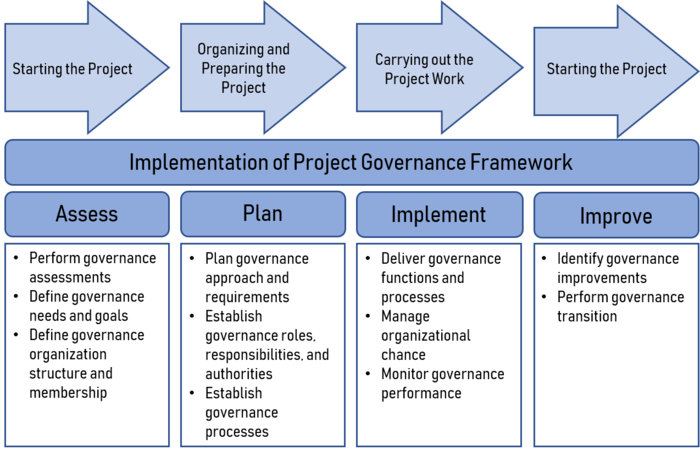
During the four-step implementation it is importance to engage stakeholders on an ongoing basis. This helps them to better understand what the changed means for them, and in that way, carry out the transition and overcome possible challenges. The ongoing communication with the stakeholders is also essential to gain and maintain the support and buy-in of the stakeholders. [4] In general transparency of governance meaning enough easily understandable and directly accessible information provided to the affected, is very important to ensure engagement of all involved in a project.[1]
13 Principles to Avoid Project Failure
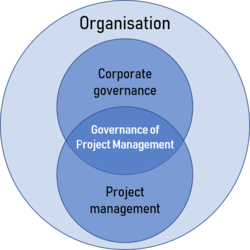
The Association of Project Management (APM) has provided a guide that identify 13 principles for governance of project management. The governance of project management is the link between the corporate governance and the activities of project management within an organisation (as shown in figure…). (The governance of project management is a subset of the activities involved with corporate governance like shown in the figure…). At the corporate level in an organisation, governance begins with the “board of directors” defining the objectives of the company and the role of projects in attaining these objectives. [2] Corporate governance also involves the relationships between the organisation’s board, management, shareholders, and other stakeholders. .[3] [1] Since the guide focuses on the coherence between corporate governance and project management processes, it is targeted the corporate level of an organisation and is formed as a “check-list” for the board of directors.[3]
The 13 principles are as listed below: [3]
- The board has overall responsibility for the governance of project management.
- The organisation differentiates between projects and non project-based activities.
- Roles and responsibilities for the governance of project management are defined clearly.
- Disciplined governance arrangements, supported by appropriate methods, resources and controls are applied throughout the project life cycle. Every project has a sponsor.
- There is a demonstrably coherent and supporting relationship between the overall business strategy and the project portfolio.
- All projects have an approved plan containing authorisation points at which the business case, inclusive of cost, benefits and risk is reviewed. Decisions made at authorisation points are recorded and communicated.
- Members of delegated authorisation bodies have sufficient representation, competence, authority and resources to enable them to make appropriate decisions.
- Project business cases are supported by relevant and realistic information that provides a reliable basis for making authorisation decisions.
- The board or its delegated agents decide when independent scrutiny of projects or project management systems is required and implement such assurance accordingly.
- There are clearly defined criteria for reporting project status and for the escalation of risks and issues to the levels required by the organisation.
- The organisation fosters a culture of improvement and of frank internal disclosure of project management information.
- Project stakeholders are engaged at a level that is commensurate with their importance to the organisation and in a manner that fosters trust.
- Projects are closed when they are no longer justified as part of the organisation’s portfolio
APM states that applying these principles would help avoid common causes of project failure such as lack of a clear link with key strategic priorities, and lack of effective engagement with stakeholders. Other common causes of project failure is listed in “Directing Change - A guide to governance of project management” by APM.[3]
Project Governance Model
Limitations
Annotated bibliography
This article searches to give an overview of governance at the project level and present different methods and guides for implementing governance. For additional information it is recommended to visit these three sources.
Governance of Portfolios, Programs, and Projects: A Practice Guide by PMI (2016)[4] This practice guide is a complementary document to PMI’s standards and provides more detailed information and further understanding of governance in relation to both projects, programs, and portfolios. Furthermore, it provides guidance to organisations and practitioners on how to implement and enhance governance on projects, programs, and portfolios.
Directing Change – A guide to governance of project management by APM (2011)[3] This guide provides information on how organisations should oversee the management of projects. It explains how good governance requirements apply to the direction and management of the organisations project portfolio. The guide lists principles of how to avoid project failure that the directors should adopt and questions that they should ask. The guide can be used internationally and by both the public, private or a third sector.
Project Governance - Implementing Corporate Governance and Business Ethics in Nonprofit Organizations by Patrick S. Renz (2007)[5] This book presents a Project Governance Model that is a conclusion of several studies, theoretical groundwork, and best practises. It goes through the process of implementing governance and is targeted non-profit organisations and development projects. The book is very thorough and provides plenty of additional information and detailed examples of the six modules in the Project Governance Model, which is only summarised in this article.
References
- ↑ 1.0 1.1 1.2 1.3 1.4 1.5 Kelly, É. V. (2010). Governance rules! The principles of effective project governance. Paper presented at PMI® Global Congress 2010—North America, Washington, DC. Newtown Square, PA: Project Management Institute.
- ↑ 2.0 2.1 2.2 2.3 Müller, Ralf (2011). Project Governance. Volume 12, Issue 5, Upgrade: The European Journal for the Informatics Professional
- ↑ 3.0 3.1 3.2 3.3 3.4 3.5 3.6 3.7 3.8 3.9 Association for Project Management (2011). Directing Change – A guide to governance of project management. 2nd edition, APM
- ↑ 4.00 4.01 4.02 4.03 4.04 4.05 4.06 4.07 4.08 4.09 4.10 4.11 4.12 4.13 4.14 4.15 Project Management Institute (2016). Governance of Portfolios, Programs, and Projects: A Practice Guide. PMI
- ↑ 5.0 5.1 5.2 5.3 5.4 Renz, Patrick S. (2007). Project Governance - Implementing Corporate Governance and Business Ethics in Nonprofit Organizations. Physica-Verlag HD
- ↑ 6.0 6.1 6.2 6.3 6.4 Project Management Institute (2017). A guide to the Project Management. Body of Knowledge (PMBOK guide). 6th Edition, PMI
- ↑ 7.0 7.1 7.2 7.3 AXELOS (2017). Managing Successful Projects with PRINCE2. 6th edition, TSO (The Stationery Office)
